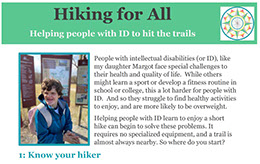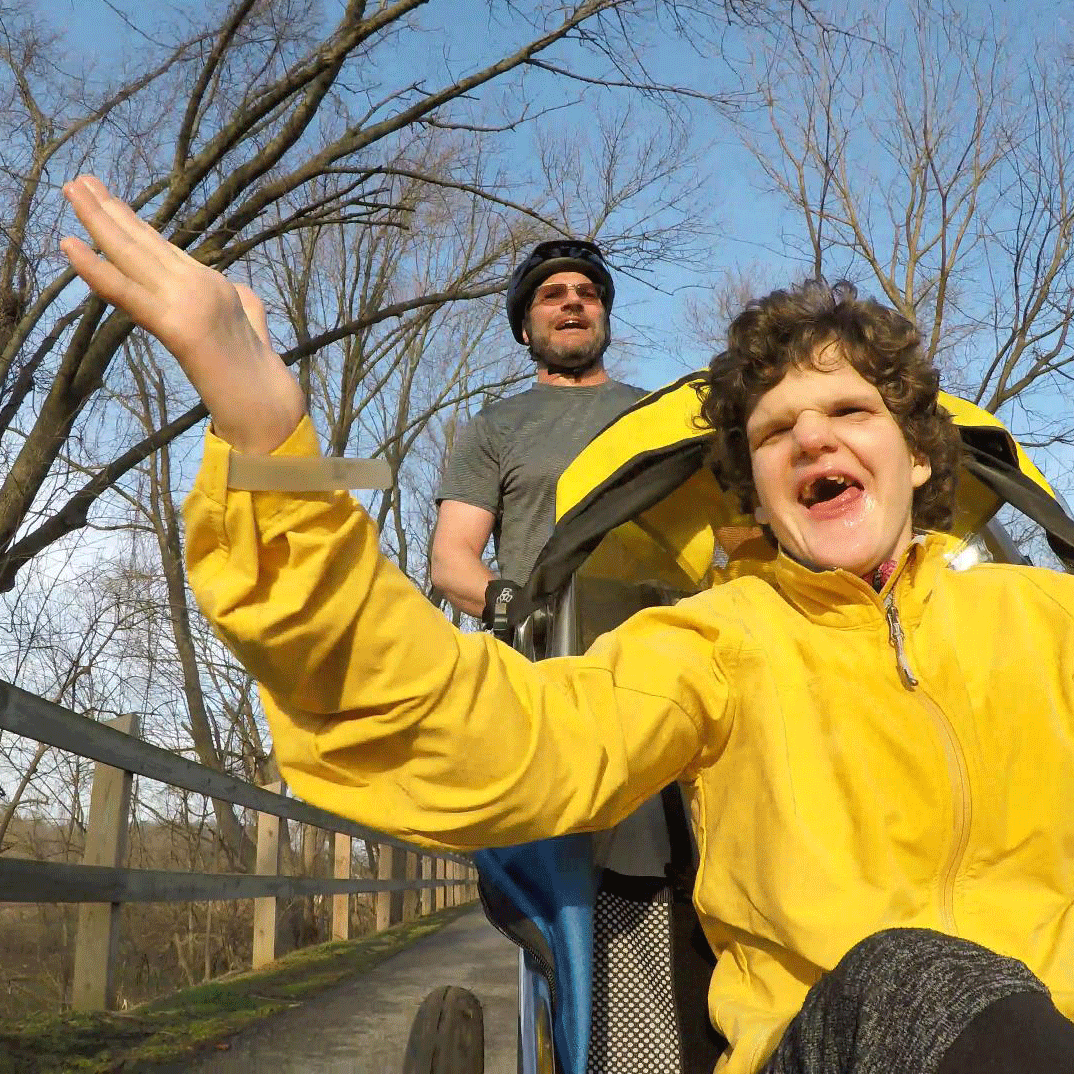Hiking for Everyone
Imagine how trail systems, practices, and programs that help people with ASD and/or intellectual disabilities begin to hike might impact health and quality of life!
March 20, 2020
The gaps in health and quality of life for young people with Autism Spectrum Disorder (ASD) and/or intellectual / developmental disabilities (I/DD) are well-documented. One especially notable gap that impacts both physical health and quality of life is in the area of outdoor recreation. Those outdoor recreation activities that involve the most physical exercise include biking, hiking, running, canoing/kayaking, horseback riding, and skiing.
Of the different possible outdoor activities to promote physical fitness, hiking is perhaps the most versatile and the most accessible to people with I/DD. Hiking is a natural extension of walking. It is one of the first skills we acquire, one of the most essential activities of daily life, and one of the few forms of recreation that requires no equipment. It can grow into a vigorous, all-day hike up and down a mountain, or into a multi-day trek. Except perhaps for the most densely populated urban areas, there are almost always trails nearby; even then, urban hikes that meander across a city are becoming increasingly popular.
One reason to focus on hiking is because other outdoor recreation activities that promote physical fitness present other challenges. For example, biking draws upon additional physical and cognitive skills. Activities like skiing and horseback riding require specialized facilities that are not always easily accessible, especially for underserved groups, and even more so for those in urban areas. All of these activities also raise other important safety concerns for people with I/DD. While none of these are insurmountable, they nonetheless represent significant barriers, especially to families already struggling just to get by. But to hike, you just need good shoes and a place to walk, and there is almost always a park within an easy drive by car or bus. This makes it very reasonable to build hikes into a weekly fitness routine.
.jpg?crc=3890483898) Getting ready to hike at CheslenWe envision programs to promote weekly hikes among people with I/DD as a three-legged stool: carefully curated trails, effective teaching practices, and programs to provide support. We begin by focusing on the first leg: how to create an inventory of local trails that offer progressive access towards adventure - i.e., hikes of gradually greater length and difficulty (summarized here). Later, we describe teaching practices that help to build a functional hiking routine, and finally programs to track the progress and share the success these young people have achieved. All of these depend, however, on an understanding of the characteristics commonly seen in people with I/DD, and how these might shape the trail systems, practices, and programs required. These are captured in a set of sample guidelines, matched with a detailed trail inventory for the Kennett Square region. Links to more detailed descriptions, and definitions of key terms, are offered below.
Getting ready to hike at CheslenWe envision programs to promote weekly hikes among people with I/DD as a three-legged stool: carefully curated trails, effective teaching practices, and programs to provide support. We begin by focusing on the first leg: how to create an inventory of local trails that offer progressive access towards adventure - i.e., hikes of gradually greater length and difficulty (summarized here). Later, we describe teaching practices that help to build a functional hiking routine, and finally programs to track the progress and share the success these young people have achieved. All of these depend, however, on an understanding of the characteristics commonly seen in people with I/DD, and how these might shape the trail systems, practices, and programs required. These are captured in a set of sample guidelines, matched with a detailed trail inventory for the Kennett Square region. Links to more detailed descriptions, and definitions of key terms, are offered below.
What is possible? Hiking is now an essential part of Margot's own fitness. She enjoys 60-90 minute hikes, 2-3 times per week. She hikes with us, with other caregivers, and now with school staff. It has preserved our sanity during the COVID pandemic: she has hiked once or twice a day, 1 1/2 or 2 miles at a time, and now even helps us to clear debris from trails we help to manage. We are looking forward to adding hiking to our repertoire of activities for our summer vacations, giving us even more options to break up long drives, and preserve a daily routine once we reach our destination. Margot is now an adventurous hiker, and we are looking forward to testing her on half-day excursions . And we are especially eager to pilot a program with schools and other community partners in our region, to introduce others like Margot to the wonders of hiking.
Key characteristics of hikers with I/DD
Hiking can present special challenges to people with I/DD. Matching their needs and preferences to different kinds of trails can help hiking planners and partners to find the perfect hike.
How can I find trails now?
How many trails appropriate for a beginning hiker are within an easy drive? A detailed inventory of hikes in our own region reveals just how overwhelming these choices are for beginner hikers.
Existing trail ratings systems
While the criteria and the costs of creating accessible trails are very well understood, the criteria and costs for creating other trails of varying levels of difficulty are much less certain.
Access adventure
Progressive access uses data to guide planners in selecting hikes over multiple stages, carefully calibrated to gradually build the capabilities of hikers to take on more and more challenging trails.
Building a hiking community!
Imagine a community of hikers from local partners (like schools, churches, fitness clubs), and the potential to create new social connections, and to build a regional trail inventory together!
Evidenced-based practices for hikers
Core EBPs identified as effective for teaching other skills or preventing problems in people with ASD can be readily adapted to building hiking skills and endurance for those with I/DD.
Building a regional trail inventory
Applying progressive access to the inventory of trails in our region reveals the many different options available for hikers at each stage, and how a community of hikers can fill in gaps in the data.
Coming soon
Some definitions
Some definitions here will help to facilitate the more detailed discussions which follow.
People
- Throughout this document, we refer to people with I/DD as our hikers.
- Anyone providing support during a hike is a hiking partner, and anyone responsible for selecting hikes as a hiking planner. This helps to break down and allocate the range of tasks that must be undertaken to get hikers out onto trails of increasing difficulty. This also recognizes that many different people - family members, peers, volunteers, or paid staff - can perform many of the functions, with the right guidance. And these days, the task of partner and planner will most likely fall on parents.
- A regional hiking coordinator draws upon the principles of progressive access to assess existing trails using available GPX data, without the need to first assess each individual trail. Based on this assessment, a coordinator can create a preliminary inventory of trails useful to beginning hikers.
Trail, segments, hikes, oh no!
- A trail refers to the actual path on a map. We also divide many trails into half-mile segments , and that may end at a natural waypoint (like a bench or other resting place).
- A hike is the experience of the hiker walking that path, and so a hiker may choose a hike that covers only some segments of a trail. While some hikers may eventually seek longer hikes, we are initially interested in helping new hikers to begin this journey. Dividing trails into half-mo;e segments can also be very helpful when the difficulty level varies significantly over the course of a trail.
In general, our focus here is on short hikes, or a walk of 30 to 90 minutes, for a half mile and up to 3 miles, in a natural setting. These short hikes require relatively less planning, making it more realistic to plan and to complete such hikes weekly, if not several times each week. Unless designated as a loop, hikes here are presumed to be out and back, requiring the hiker to retrace their route.


